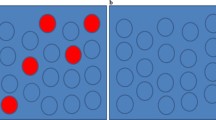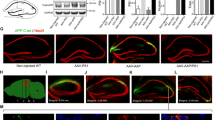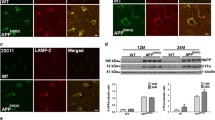Abstract
Trimethyltin (TMT) chloride induces limbic system neurodegeneration, resulting in behavioral alterations including cognitive deficits. Different factors related to Alzheimer’s disease (AD) were studied after TMT lesion in Sprague-Dawley rats. The expression of amyloid precursor protein (APP) containing 695 amino acids (APP695), APP containing the Kuniz protease inhibitor domain (APP-KPI), presenilin 1 (PS1), c-fos and IL-1β was investigated at different timepoints after a single TMT injection (7 mg/kg i.p.) using in situ hybridization and immunohistochemistry.
After the TMT treatment, extensive degeneration of pyramidal neurons was observed in the CA3 region of the hippocampus, concomitant with neurodegeneration in the outer layer of the CA1 region and layer II of enterhinal and piriform cortex. The affected regions showed abundant condensed eosinophilic and TUNEL-positive neuronal cells, that were apparent at day 4 after TMT, increasing to day 7 and subsequently disappearing. In the affected regions the levels of APP695 mRNA gradually declined with time after the TMT injection. While there was no apparent alteration in the overall expression of APP-KPI or PS1 mRNA, detailed analysis of the CA3c region showed that the mRNA expression shifted from neurons to glial cells. Three days after TMT, neurons in the piriform cortex, the CA3 region and DG expressed high levels of c-fos mRNA that slowly declined to become normalized when analyzed at day 28. At day 7 after TMT a few distinct IL-1β mRNA expressing glial cells were observed in the CA3c region.
Thus, TMT exposure leads to alterations in the expression of APP, APP-KPI, PS1, c-fos and IL-1β in the limbic system. These findings suggest that TMT lesions, not only share certain key features of AD symptomatology and regional neurodegeneration, but also induce effects on important factors related to the pathophysiology of AD.
Similar content being viewed by others
References
Abrous, D.N., Rodriguez, J., le Moal, M., Moser, P.C. and Barneoud, P. (1999) “Effects of mild traumatic brain injury on immunoreactivity for the inducible transcription factors c-Fos, c-Jun, JunB, and Krox-24 in cerebral regions associated with conditioned fear responding,” Brain Res. 826, 181–192.
Aldridge, W.N., Street, B.W. and Skilleter, D.N. (1977) “Oxidative phosphorylation. Halide-dependent and halide-independent effects of triorganotin and trioganolead compounds on mitochondrial functions,” Biochem. J. 168, 353–364.
Ali, S.F., Slikker, Jr., W., Newport, G.D. and Goad, P.T. (1986) “Cholinergic and dopaminergic alterations in the mouse central nervous system following acute trimethyltin exposure,” Acta Pharmacol. Toxicol. 59, 179–188.
Anderson, V.E., Hajimohammadreza, I., Gallo, J.M., Anderton, B.H., Uney, J., Brown, A.W., Nolan, C.C., Cavanagh, J.B. and Leigh, P.N. (1992) “Ubiquitin, PGP 9.5 and dense body formation in trimethyltin intoxication: differential neuronal responses to chemically induced cell damage,” Neuropathol. Appl. Neurobiol. 18, 360–375.
Andersson, H., Luthman, J., Lindqvist, E. and Olson, L. (1995) “Time-course of trimethyltin effects on the monoaminergic systems of the rat brain,” Neurotoxicology 16, 201–210.
Andersson, H., Luthman, J., Wetmore, C., Lindqvisit, E. and Olson, L. (1997) “Trimethyltin exposure in the rat induces delayed changes in brain-derived neurotrophic factor, fos and heat shock protein 70,” Neurotoxicology 18, 147–160.
Beal, M.F. (1995) “Mitochondrial Dysfunction and Oxidative Damage in Neurodegenerative Diseases” (Springer-Verlag, New York), pp 89–96.
Bouldin, T.W., Goines, N.D., Bagnell, C.R. and Krigman, M.R. (1981) “Pathogenesis of trimethyltin neuronal toxicity: ultrastructural and cytochemical observations,” Am. J. Pathol. 104, 237–249.
Braak, H. and Braak, E. (1991) “Neuropathological staging of Alzheimer-related changes” Acta Neuropathol. 82, 239–259.
Brown, A.W., Aldridge, W.N., Street, B.W. and Verschoyle, R.D. (1979) “The behavioural and neuropathologic sequeale of intoxication by trimethyltin compounds in the rat,” Am. J. Pathol. 97, 59–81.
Bruccoleri, A., Brown, H. and Harry, G.J. (1998) “Cellular localization and temporal elevation of tumor necrosis factor-alpha, interleukin-1 alpha, and transforming growth factor-beta 1 mRNA in hippocampal injury response induced by trimethyltin,” J. Neurochem. 71, 1577–1587.
Bruccoleri, A., Pennypacker, K.R. and Harry, G.J. (1999) “Effect of dexamethasone on elevated cytokine mRNA levels in chemicalinduced hippocampal injury”, J. Neurosci. Res. 57, 916–926.
Cannon, R.L., Hoover, D.B., Baisden, R.H. and Woodruff, M.L. (1994) “The effect of time following exposure to trimethyltin (TMT) on cholinergic muscarinic receptor binding in rat hippocampus”, Mol. Chem. Neuropathol. 23, 47–62.
Chandrasekaran, K., Hatanpaa, K., Brady, D.R. and Rapoport, S.I. (1996) “Evidence for physiological down-regulation of brain oxidative phosphorylation in Alzheimer’s disease”, Exp. Neurol. 142, 80–88.
Chang, L.W. and Dyer, R.S. (1983) “A time-course study of trimethyltin induced neuropathology in rats”, Neurobehav. Toxicol. Teratol. 5, 443–459.
Cho, S., Park, E.M., Kim, Y., Liu, N., Gal, J., Volpe, B.T. and Joh, T.H. (2001) “Early c-Fos induction after cerebral ischemia: a possible neuroprotective role”, J. Cereb. Blood Flow Metab. 21, 550–556.
Cook, L.L., Stine, K.E. and Reiter, L.W. (1986) “Tin distribution in adult rat tissues after exposure to trimethyltin and triethyltin”, Toxicol. Appl. Pharmacol. 76, 344–348.
Coulson, E.J., Paliga, K., Beyreuther, K. and Masters, C.L. (2000) “What the evolution of the amyloid protein precursor supergene family tells us about its function”, Neurochem. Int. 36, 175–184.
Curran, T., Gordon, M.B., Rubino, K.L. and Sambucetti, L.C. (1987) “Isolation and characterization of the c-fos(rat) cDNA and analysis of post-translational modification in vitro”, Oncogene 2, 79–84.
Dagerlind, Å., Friberg, K., Bean, A.J. and Hökfelt, T. (1992) “Sensitive mRNA detection using unfixed tissue: combined radioactive and non-radioactive in situ hybridization histochemistry”, Histochemistry 98, 39–49.
Dragunow, M. and Robertson, H.A. (1990) “Brain injury induces c-fos protein(s) in nerve and glial-like cells in adult mammalian brain”, Brain Res. 455, 295–299.
Dyer, R.S., Walsh, T.J., Wonderlin, W.F. and Bercegeay, M. (1982) “The trimethyltin syndrome in rats”, Neurobehav. Toxicol. Teratol. 4, 127–133.
Earley, B., Burke, M., Leonard, B.E., Gouret, C.J. and Junien, J.L. (1990) “A comparison of the psychopharmacological profiles of phencyclidine, ketamine and (+) SKF 10,047 in the trimethyltin rat model”, Neuropharmacology 29, 695–703.
Earley, B., Burke, M. and Leonard, B.E. (1992) “Behavioural, biochemical and histological effects of trimethyltin (TMT) induced brain damage in the rat”, Neurochem. Int. 21, 351–366.
Eikelenboom, P., Rozemuller, A.J., Hoozemans, J.J., Veerhuis, R. and van Gool, W.A. (2000) “Neuroinflammation and Alzheimer disease: clinical and therapeutic implications”, Alzheimer Dis. Assoc. Disord. 14, S54-S61.
Esler, W.P. and Wolfe, M.S. (2001) “A portrait of Alzheimer secretases—new features and familiar faces”, Science 293, 1449–1454.
Eyer, C.L., Rio, C. and Smith, J.R. (2000) “Trimethyltin reduces ATP levels and MTT reduction in the LRM55 rat astrocytoma cell line”, In Vitro Mol. Toxicol. 13, 263–268.
Feuerstein, G.Z., Wang, X. and Barone, F.C. (1998) “The role of cytokines in the neuropathology of stroke and neurotrauma”, Neuroimmunomodulation 5, 143–159.
Fiedorowicz, A., Figiel, I., Kaminska, B., Zaremba, M., Wilk, S. and Oderfeld-Nowak, B. (2001) “Dentate granule neuron apoptosis and glia activation in murine hippocampus induced by trimethyltin exposure”, Brain Res. 912, 116–127.
Fortemps, F., Amand, G., Bomboir, A., Lauwerys, R. and Laterre, E.C. (1978) “Trimethyltin poisoning-report of two cases”, Int. Arch. Occup. Environ. Health 41, 1–6.
Garcia, M.L. and Cleveland, D.W. (2001) “Going new places using an old MAP: tau, microtubules and human neurodegenerative diseases”, Curr. Opin. Cell Biol. 13, 41–48.
Griffin, W.S., Sheng, J.G., Royston, M.C., Gentleman, S.M., McKenzie, J.E., Graham, D.I., Roberts, G.W. and Mrak, R.E. (1998) “Glial-neuronal interactions in Alzheimer’s disease: the potential role of a cytokine cycle in disease progression”, Brain Pathol. 8, 65–72.
Hagan, J.J., Jensen, J.H.M. and Broekkamp, C.L.E. (1988) “Selective behavioural impairment after acute intoxication with trimethyltin (TMT) in rats”, Neurotoxicology 9, 53–74.
Horsburgh, K. and Saitoh, T. (1994) “Altered signal transduction in Alzheimer’s disease”, In: Terry, R.D., Katzman, R. and Bick, K.L., eds, Alzheimer Disease (Raven Press, New York), pp. 387–404.
Hyman, B.T. (2001) “Molecular and anatomical studies in Alzheimer’s disease”, Neurologia 16, 100–104.
Ishikawa, K., Kubo, T., Shibanoki, S., Matsumoto, A., Hata, H. and Asai, S. (1997) “Hippocampal degeneration inducing impairment of learning in rats: model of dementia?”, Behav. Brain Res. 83, 39–44.
Maier, W.E., Brown, H.W., Tilson, H.A., Luster, M.I. and Harry, G.J. (1995) “Trimethyltin increases interleukin (IL)-1 alpha, IL-6 and tumor necrosis factor alpha mRNA levels in rat hippocampus”, J. Neuroimmunol. 59, 65–75.
Masliah, E., Mallory, M., Alford, M., Tanaka, S. and Hansen, L.A. (1998) “Caspase dependent DNA fragmentation might be associated with excitotoxicity in Alzheimer disease”, J. Neuropathol. Exp. Neurol. 57, 1041–1052.
McCann, M.J., O’Callaghan, J.P., Martin, P.M., Bertram, T. and Streit, W.J. (1996) “Differential activation of microglia and astrocytes following trimethyl tin-induced neurodegeneration”, Neuroscience 72, 273–281.
Minami, M., Kuraishi, Y. and Satoh, M. (1991) “Effects of kainic acid on messenger RNA levels of IL-1 beta, IL-6, TNF alpha and LIF in the rat brain”, Biochem. Biophys. Res. Commun. 176, 593–598.
Minami, M., Kuraishi, Y., Yabuuchi, K., Yamazaki, A. and Satoh, M. (1952) “Induction of interleukin-1 beta mRNA in rat brain after transient forebrain ischemia”, J. Neurochem. 58, 390–392.
Nilsberth, C., Luthman, J., Lannfelt, L. and Schultzberg, M. (1999) “Expression of presenilin 1 mRNA in rat peripheral organs and brain”, Histochem. J. 31, 515–523.
Nobel, C.S. and Schultzberg, M. (1995) “Induction of interleukin-1 beta mRNA and enkephalin mRNA in the rat adrenal gland by lipopolysaccharides studied by in situ hybridization histochemistry”, Neuroimmunomodulation 2, 61–73.
Nolan, C.C., Brown, A.W. and Cavanagh, J.B. (1990) “Regional variations in nerve cell responses to trimethyltin intoxication in Mongolian gerbils and rats; further evidence for involvement of the Golgi apparatus”, Acta Neuropathol. 81, 204–212.
O’Connell, A., Earley, B. and Leonard, B.E. (1994) “Changes in muscarinic (M1 and M2 subtypes) and phencyclidine receptor density in the rat brain following trimethyltin intoxication”, Neurochem. Int. 25, 243–252.
O’Connell, A.W., Strada, O., Earley, B. and Leonard, B.E. (1997) “Altered expression of amyloid protein precursor mRNA in the rat hippocampus following trimethyltin intoxication: an in situ hybridization study”, Neurochem. Int. 30, 313–320.
Oppenheim, G. (1994) “The earliest signs of Alzheimer’s disease”, Geriatr. Psychiatry Neurol. 7, 118–122.
Page, K., Hollister, R., Tanzi, R.E. and Hyman, B.T. (1996) “In situ hybridization analysis of presenilin 1 mRNA in Alzheimer disease and in lesioned rat brain”, Proc. Natl Acad. Sci. USA 93, 14020–14024.
Powers, M.F. and Beavis, A.D. (1991) “Triorganotins inhibit the mitochondrial inner membrane anion channel”, J. Biol. Chem. 266, 17250–17256.
Ross, W.D., Emmett, E.A., Steiner, J. and Tureen, R. (1981) “Neurotoxic effects of occupational exposure to organotins”, Am. J. Psychiatry 138, 1092–1095.
Rubin, E.H., Morris, J.C. and Berg, L. (1987) “The progression of personality changes in senile dementia of the Alzheimer’s type”, J. Am. Geriatr. Soc. 35, 721–725.
Selkoe, D.J. (1999) “Translating cell biology into therapeutic advances in Alzheimer’s disease”, Nature 399, A23-A31.
Selwyn, M.J. (1976) “Triorganotin compounds as ionophores and inhibitors of ion translocating ATPases”, In: Zuckerman, J.J., ed, Organotin Compounds: New Chemistry and Applications (American Chemical Society, Washington, DC), pp 204–225.
Sheng, J.G., Mrak, R.E. and Griffin, W.S. (1995) “Microglial interleukin-1 alpha expression in brain regions in Alzheimer’s disease: correlation with neuritic plaque distribution”, Neuropathol. Appl. Neurol. 21, 290–301.
Sheng, J.G., Griffin, W.S., Royston, M.C. and Mrak, R.E. (1998) “Distribution of interleukin-1-immunoreactive microglia in cerebral cortical layers: implications for neuritic plaque formation in Alzheimer’s disease”, Neuropathol. Appl. Neurol. 24, 278–283.
Shivers, B.D., Hilbich, C., Multhaup, G., Salbaum, M., Beyreuther, K. and Seeburg, P.H. (1988) “Alzheimer’s disease amyloidogenic glycoprotein: expression pattern in rat brain suggests a role in cell contact”, EMBO J. 7, 1365–1370.
Solà, C., Mengod, G., Probst, A. and Palacios, J.M. (1993) “Differential regional and cellular distribution of β-amyloid precursor protein messenger RNAs containing and lacking the Kunitz protease inhibitor domain in the brain of human, rat and mouse”, Neuroscience 53, 267–295.
Stine, K.E., Reiter, L.W. and Leinasters, J.J. (1988) “Alkyltin inhibition of ATPase activities in tissue homogenates and subcellular fractions from adult and neonatal rats”, Toxicol. Appl. Pharmacol. 94, 394–406.
Su, J.H., Anderson, A.J., Cummings, B. and Cotman, C.W. (1994) “Immunocytochemical evidence for apoptosis in Alzheimer’s disease”, Neuroreport 5, 2529–2533.
Suzuki, T., Nishiyama, K., Murayama, S., Yamamoto, A., Sato, S., Kanazawa, I. and Sakaki, Y. (1996) “Regional and cellular presenilin 1 gene expression in human and rat tissues”, Biochem. Biophys. Res. Commun. 219, 708–713.
Swartzwelder, H.S., Hepler, J., Holahan, W., King, S.E., Leverenz, H.A., Miller, P.A. and Myers, R.D. (1982) “Severely impaired maze performance in the rat caused by trimethyltin treatment: problem-solving deficits and preservation”, Neurobehav. Toxicol. Teratol. 4, 169–176.
Takahashi, H., Murayama, M., Takashima, A., Mercken, M., Nakazato, Y., Noguchi, K. and Imahori, K. (1996) “Molecular cloning and expression of the rat homologue of presenilin-1”, Neurosci. Lett. 206, 113–116.
Tanimukai, H., Imaizumi, K., Kudo, T., Katayama, T., Tsuda, M., Takagi, T., Tohyama, M. and Takeda, M. (1998) “Alzheimerassociated presenilin-1 gene is induced in gerbil hippocampus after transient ischemia”, Mol. Brain Res. 54, 212–218.
Walsh, T.J., Miller, D.B. and Dyer, R.S. (1982) “Trimethyltin, a selective limbic system neurotoxicant, impairs radial-maze performance”, Neurobehav. Toxicol. Teratol. 4, 177–183.
Woodruff, M.L. and Baisden, R.H. (1990) “Exposure to trimethyltin significantly enhances acetylcholinesterase staining in the rat dentate gyrus”, Neurotoxicol. Teratol. 12, 33–39.
Woodruff, M.L. and Baisden, R.H. (1994) “Trimethyltin neurotoxicity in the rat as an analogous model of Alzheimer’s disease”, In: Woodruff, M.L. and Nonneman, A.J., eds, Toxin-Induced Models of Neurological Disorders. (Plenum Press, New York), pp 319–335.
Wragg, R. and Jeste, D. (1989) “Overview of depression and psychosis in Alzheimer’s disease”, Am. J. Psychiatry 146, 577–587.
Xiao, Y., Harry, G.J. and Pennypacker, K.R. (1999) “Expression of AP-1 transcription factors in rat hippocampus and cerebellum after trimethyltin neurotoxicity”, Neurotoxicology 20, 761–766.
Yang, K., Mu, X.S., Xue, J.J., Whtison, J., Salminen, A., Dixon, C.E., Liu, P.K. and Hayes, R.L. (1994) “Increased expression of c-fos mRNA and AP-1 transcription factors after cortical impact injury in rats”, Brain Res. 664, 141–147.
Yamaguchi, T., Kuraishi, Y., Minami, M., Nakai, S., Hirai, Y. and Satoh, M. (1991) “Methamphetamine-induced expression of interleukin-1 beta mRNA in the rat hypothalamus”, Neurosci. Lett. 128, 90–92.
Yanofsky, N.N., Nierenberg, D. and Turco, J.H. (1991) “Acute short-term memory loss from trimethyltin exposure”, J. Emerg. Med. 9, 137–139.
Zawia, N.H. and Harry, G.J. (1993) “Trimethyltin-induced c-fos expression: adolescent vs neonatal rat hippocampus”, Toxicol. Appl. Pharmacol. 121, 99–102.
Author information
Authors and Affiliations
Corresponding author
Rights and permissions
About this article
Cite this article
Nilsberth, C., Kostyszyn, B. & Luthman, J. Changes in APP, PS1 and other factors related to Alzheimer’s disease pathophysiology after trimethyltin-induced brain lesion in the rat. neurotox res 4, 625–636 (2002). https://doi.org/10.1080/1029842021000045471
Received:
Revised:
Accepted:
Issue Date:
DOI: https://doi.org/10.1080/1029842021000045471




